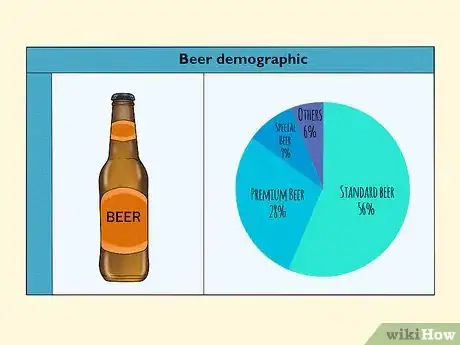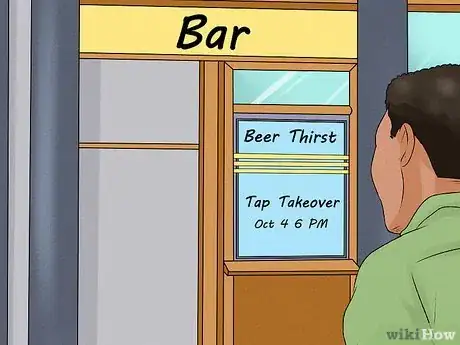X
wikiHow is a “wiki,” similar to Wikipedia, which means that many of our articles are co-written by multiple authors. To create this article, volunteer authors worked to edit and improve it over time.
This article has been viewed 13,791 times.
Learn more...
The beer industry is a popular one and makes lots of money. If you're a small brewery looking to break into the business, this wikiHow can help you understand your market and start selling your beer.
Steps
Part 1
Part 1 of 4:
Researching Your Market
-
1Get to know the market in your area. Find out what types of beers are being sold by the breweries, bars, and businesses in your city. See if there are trends toward certain beer genres and breweries. This will help you to determine the types of beer drinkers that are providing business in the area.
- You may find that the most prevalent watering holes in the area are sports bars with a limited selections of domestic drafts. Or you might be in an area with several nearby breweries, and bars that are full of local craft beer.
- Whatever the case may be, this can help you to assess the level of exposure the community has had to certain beers, as well as giving you insight into what is popular. Most of those businesses exist because they are selling a product people want, some of these products can eventually come from you.
-
2Get to know the demographic of your client’s clientele. Having a rough idea of the average incomes in the area will give you an idea of the price points your products need to hit. If you are selling beer in a blue collar working class town, you may find that your more expensive products won’t sell as well.
- There are many factors than affect a beers popularity in a certain area. The locality, recognizability, price, scarcity, and genre of a beer are some of the main variables that are judged by a consumer.
- However, consumers also have their own set of variables that can determine the types of beer they are likely to drink. These include the consumers exposure to certain genres of beer, the amount of money they expect to or are used to be spending on beer, the types of beer that are popular at popular drinking locations, and many others.
- The chart below is one example of some likely correlations between beer classifications and demographic variables.
Advertisement - There are many factors than affect a beers popularity in a certain area. The locality, recognizability, price, scarcity, and genre of a beer are some of the main variables that are judged by a consumer.
-
3Identify trends in the alcohol/beer market. Read beer magazines, look at the larger beer/brewery competitions, and see what categories/genres of beer there are popular. You may notice some breweries that win a lot of beer awards. These breweries are likely to become popular if they are not already. You may notice buzz about an emerging newer genre of beer that is gaining steam. For example, in recent years a style of IPA called “New England Style IPA” became very popular across the country.
- The first businesses that started carrying that beer when it was gaining popularity may have earned more business from patrons who were specifically looking for that type of beer. These types of trends and emerging beers are changing all the time, so it takes a maintained diligence to keep up with the trends in order to maximize the sales of a business as well as your own sales. This also feeds back into knowing your client's customers preferences.
- There are some people who will only drink at bars that carry the type of beer they want to drink. By keeping up with the trends you are ensuring a more likely chance to secure these specific beer hunters as customers.
Advertisement
Part 2
Part 2 of 4:
Working With Clients
-
1Get to know the clients/businesses. Find out what the owners and managers like to drink as well as their customers. Personal taste often comes into play when a business is ordering a product.
- At times the decision to order something can come down to whether or not the ordering manager likes the beer or not, they may not always have their patrons first in mind. Also learn what your clients want to be known for when it comes to their beer selection.
- Some businesses may want to maintain a trusty domestic selection of Budweiser, Coors, Miller, etc. Others may want to be known as the spot that always has the newest rarest craft beer selections. You can help them further that image by perfecting their beer offerings based upon their wishes.
-
2Identify areas of opportunity in client’s current beer portfolio. Look for gaps in your client's beer selections that you could fill with a good beer.
- If you determine that the demographic of a business would be interested in craft beers, yet the business doesn’t carry many craft beers, then you could try to increase that genre in their selection.
-
3Create sales goals with each client business. Find out what they want, sales-wise, out of their beer selection. Do they want to hit a monthly revenue number from beer? Do they want to hit a cost percentage from beer? Business have many different ways of measuring their success in sales. Find out how your clients measure themselves, and try to assist them with their goals.
- Some may want to reduce costs, so you would try to find them lower cost products, or premium products with a larger margin between cost and price point. Others may just want to increase overall beer sales.
- You may need a different strategy for each client depending on their goals.
-
4Create personal goals with each business. You may want to obtain 30-50% of tap handles at a client's bar. You may want to sell a certain dollar amount or earn a certain commission each month. Whatever it is, create these goals, and work with your clients to achieve them. Sometimes this might involve back and forth negotiation.
- For instance, a client might want a discount in return for carrying a larger portion of your portfolio. It is common practice to charge different businesses different prices according to their buying power, among other factors.
- These price fluctuations can be affected by state law, however, and in some states discounts may not be an allowed factor.
Advertisement
Part 3
Part 3 of 4:
Building Interest in Your Beer
-
1Create strategies to introduce new products to the market. If you are carrying a popular new brewery in your portfolio, but that beer hasn’t been introduced to your area yet, you want to educate patrons on the product and increase awareness of it. There are many methods for doing this.
- One great method example is a "tap take-over" party. This is where you would make arrangements with the business for them to allow you to use several of their taps to put on beers from the new brewery of interest, usually for one night.
- In combination with the take-over you could try to get “swag” from that brewery to hand out like coasters, stickers, keychains, etc.
- You would also advertise this event at the bar, so bar patrons are even more aware of the product. By doing an event like this you can immerse the target customers in the new product, and then when it comes time to try and sell that product, people will have been exposed to it, and more likely to try it.
- One great method example is a "tap take-over" party. This is where you would make arrangements with the business for them to allow you to use several of their taps to put on beers from the new brewery of interest, usually for one night.
-
2Train/educate clients and staff on current and new products. Meet with your clients and their bar managers. Educate the managers and staff on the products from you which they carry. In most cases the more educated on a product the servers/bartenders are, the more of that product they will sell. They are the final line in your sales game.
- This always means getting the staff to want to sell your product too. It is their decision as to what they will sell, and you can bet they’ll sell more of the items they like or want to sell. That means helping the staff, getting to know them, training them (with the permission of the business), getting them samples of your products, and so on. Holding beer education classes with the permission of your clients, is a great way to start doing this.
- Furthermore, you may also be able to arrange sales contests within a business which your company, or you, supply a prize for. For instance if you are trying to push a new beer into the market, you might be able to get some bars to hold a week long or month long contest with their staff to see who can sell the most, and maybe you supply concert tickets, or dinner vouchers, etc, to the winner.
-
3Offer frequents samples of new products or products you want to sell, to client businesses and staff. One of the best ways to introduce a product and educate someone on it, is for them to try it. This is direct and simple. Stop by your clients frequently and bring them beers that you want to sell, and beers you just think they’d like.
- You don’t always have to be sales-minded, keeping your people happy is just as important as making money, and it goes hand in hand with your profits in the long run.
- Your clients may often request samples from you of a certain variety they are looking for and it will always help you to honor these requests when you can.
Advertisement
Part 4
Part 4 of 4:
Building Loyalty
-
1Check on frequent client businesses and offer assistance. Don’t ever be a stranger at your client’s businesses.
- Stop by frequently, bring them business when you can. When you have business outings, or lunch meetings, etc, try to have some of those at your client's businesses.
- Talk to the staff whether you're in on business or personal; get to know them and be charismatic. You want the staff to know you and be loyal to you. If the staff like you, some of them might push products that they know are ordered through you. This will go a long way with your product’s sales.
-
2Go above and beyond direct sales duties when possible. Offer to check tap lines/ clean them, calibrate tap system, fix tap related items etc. Be a resource to your clients; consult for them and help them with advertising if you can. Some larger beer makers will offer sales incentives and advertising dollars to businesses who sell their product.
- You may have leeway to get some posters made for a business or have a party thrown at the business on the beer makers dime. Be aware of these perks and distribute them often when you’re able.
-
3Constantly build loyalty and maintain the happiness of your clients. Assist your clients with advice/strategy, even if it involves competitor products, and be resource for them at all times.
- Be trustworthy; always be available, reliable, and resourceful. Do your best to satisfy your clients' needs, too.
Advertisement
About This Article
Advertisement


































































